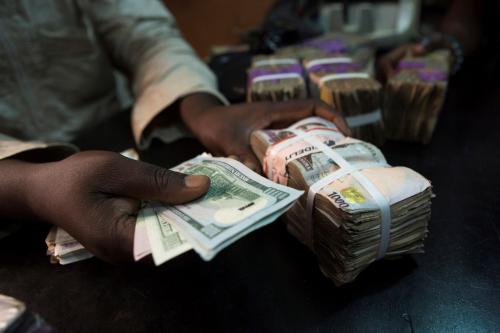Finance ministers attending the recent Spring Meetings of the International Monetary Fund and World Bank clearly heard the alarm that Indermit Gill and Kenan Karakülah sounded on African debt: The only topic for discussion at the Development Committee lunch was debt in low-income countries. The conversations in hallways and meetings reminded me of those 20 years ago, when the same countries were facing a debt crisis, which subsequently led to the Heavily Indebted Poor Countries (HIPC) Initiative and the Multilateral Debt Relief Initiative (MDRI).
The debt-relief programs of the early 2000s have generally been considered a (qualified) success. How then are we back to sounding alarm bells about African debt? At least four reasons come to mind.
PRO-CYCLICAL FISCAL POLICIES
One of the proximate reasons for high debt in many African countries is the fall in commodity prices, especially oil prices, starting in late 2014. Today, almost all African oil exporters have high debt levels and unfavorable debt dynamics. But for the first decade of the 21st century, oil and other commodities were at all-time highs. As Paul Collier and others have pointed out, most African oil producers failed to take advantage of this “commodity super-cycle” and save in advance of prices coming down (which they almost surely would). Such pro-cyclical fiscal policies appear to be common among oil producers.
What is troubling is that the rise in commodity prices contributed to the rapid growth among African countries in the early 2000s that, in turn, helped the debt-relief initiatives succeed. By not looking behind the headlines at how the higher resource revenues were being used, we may have missed the fact that the seeds of another debt crisis were being sowed. This reinforces the point that, when reporting on a resource-rich country’s economic growth, we should also report on whether that growth is (i) coming from depleting a natural resource and (ii) how far the country is from a reasonable consumption-savings mix. Putting in place institutions or rules that tie government’s hands can then help implementation of these principles.
FINANCING INFRASTRUCTURE
All HIPC/MDRI countries were subject to a “non-concessional borrowing clause,” which put limits on the extent to which they could take out loans at market interest rates. However, these countries also had huge infrastructure needs. Given low levels of domestic taxation and concessional finance, many argued that they should be able to exceed the limits on non-concessional borrowing if the money were used to finance infrastructure. Since infrastructure would promote growth, the additional debt could be repaid. The limits were therefore relaxed. Unfortunately, not all the additional borrowing was used for infrastructure; significant amounts went to consumption. Furthermore, not all the infrastructure projects were productive, so growth didn’t pick up by as much as expected. In short, while we should take into account the impact of infrastructure on growth in debt-sustainability analyses, we should also allow for the possibility that the borrowing does not lead to improvement in infrastructure services and hence to growth. Given that both possibilities exist, perhaps the best approach is to assume that the additional borrowing has no incremental effect on growth.
LOW LEVELS OF DOMESTIC TAXATION
Another reason why African countries rely on borrowing is that their tax-to-GDP ratios are very low. Nigeria’s has rarely gone above 6 percent. But Nigeria earns about $44 billion a year, or 10 percent of GDP, in oil revenues. In fact, there is an inverse correlation between resource revenues and taxation. If a country receives large oil revenues, there is little incentive to undertake politically unpopular taxation. So the problem is one of using oil revenues, rather than low taxation. A solution may be what my co-authors and I have suggested (in a different context), namely, to transfer all the oil revenues to citizens and then tax them to finance public goods.
DATA
The statistics on debt are notoriously late and incomplete. Mozambique’s “hidden debts,” which were taken out starting in 2013 but discovered only in 2017, is perhaps an extreme case, but one wonders what other surprises are lurking in the background. Given the limits on non-concessional borrowing, both lender and borrower may have an incentive to hide the data. Perhaps some international regulation that requires each loan be reported on by both creditor and debtor, with a central authority doing the matching, is in order.
As we gear up to help low-income countries manage their high-debt problems, we should keep in mind the reasons why there is a problem so soon after debt-relief, and put in place mechanisms to avoid another crisis 20 years from now.







Commentary
Low-income country debt: Déjà vu all over again?
April 25, 2018